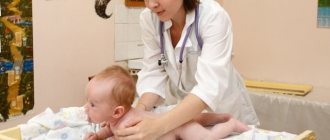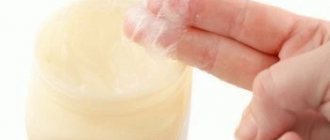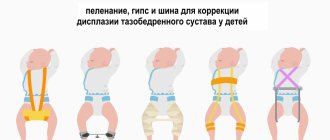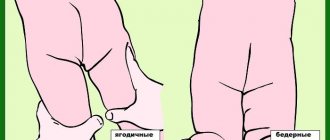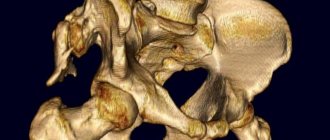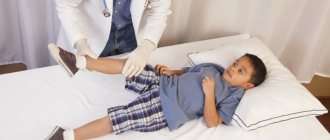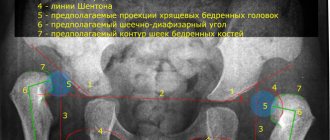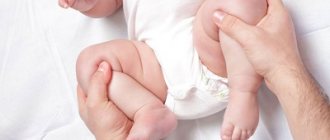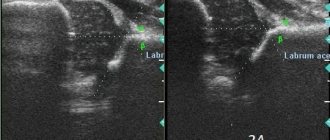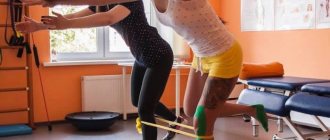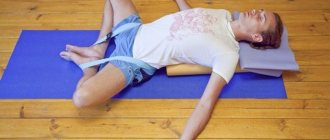Together with the usual treatment of hip dysplasia in young children, the use of exercise therapy and massage of the hip joint can significantly improve the progress of recovery. An integrated approach to the treatment of congenital hip dislocation, begun almost from the birth of the baby, helps to cope with the disease completely and so effectively that the child does not have problems with the hip joint in the future.
Gymnastics and therapeutic massage are the basis of therapeutic physical culture and complement each other for better medical therapy. Let's look at the basic recommendations for exercise therapy, its benefits and a set of exercises.
The benefits of gymnastics for dysplasia, its features
For hip dysplasia, positioning treatment is used. It includes:
- Massage;
- exercise therapy;
- Wide swaddling;
- Splinting.
These methods are used more often, given that they are quite effective. They help especially well when treatment is started early. Often, with mild dysplasia, one, or maximum two, courses of exercise therapy are used, which proves their effectiveness.
It is important to remember that until the child has learned to sit and walk, it is impossible to perform exercises such as “squatting”, “standing” and any others in an upright position. Additional stress can lead to further deformation of the hip joint. Exercise therapy here will be useless at best.
You can do physical therapy with a child with dysplasia at home. Then it is very easy to choose the right time when the child is fed and has slept well, which indicates his good health. This is important for infants. When conducting exercise therapy in a hospital, it is important to choose the same appropriate time.
It is better for the baby’s mother to entrust the first few sessions of gymnastics to a specialist, undergo instruction, and then repeat the complex at home.
For classes you need a hard surface (regular table, changing table or board). It is necessary to lay a waterproof (in case of unexpected “accidents”) or a simple diaper on it. The air temperature should be comfortable (about 21℃), and there should be no drafts in the room.
An adult's hands should be washed. They should not be cold for the child to be comfortable. Hand movements should be performed smoothly, without jerking. The child should not be in pain.
An orthopedist usually prescribes exercise therapy in a course of 10 to 15 gymnastics sessions. Additional courses after one and a half to two months are necessary to consolidate the results. At home, they can be carried out on an ongoing basis several times a day until complete recovery.
Causes of hip dysplasia in children and adults
The occurrence of a disease can be determined by a combination of several reasons.
A hereditary predisposition is clearly visible - the pathological disorder occurs 10 times more often in patients whose parents had pathological disorders of the hip joint.
There are high risks of giving birth to a baby with the pathology in question during presentation (breech).
The risks of the disease are highest among children whose mothers experienced severe toxicosis or gynecological diseases during pregnancy. Risk factors also include oligohydramnios and relatively large fetal size.
Numerous studies suggest a relationship between the frequency of diseases and the favorable environmental situation in the patient’s region of residence. According to the data obtained, in a polluted environment, the disease occurs several times more often than in regions with a favorable environment.
It is also worth noting that the progression of pathology can also be influenced by traditional features of swaddling newborns. If new parents refuse swaddling and the baby’s legs are in a natural position, the diagnosis is several times less common than where it is customary to swaddle children tightly.
Preparing for gymnastics
Before the lessons themselves, the child needs to be prepared. Warming up will allow the main gymnastics course to be more effective .
First, they begin to massage the outer thighs, then the rest of the legs, including the ankle and feet themselves. The inner surface of the thighs near the genitals should not be touched. Second stage: lightly rub in a circle or with direct movements (without moving the skin or squeezing strongly) the most damaged joint.
Symptoms
Dysplasia can only be diagnosed by a specialist. Therefore, if you do not have a medical education, do not try to diagnose yourself.
In infants (up to 10 days)
Ortolani-Marx sign (slipping)
Like the previous method, it works for infants up to 10 days old. The baby is placed on his back, legs bent at the knees. The bend angle should be 90 degrees. The thumbs are placed on the inner surfaces of the thigh. The outer one is held with the middle and index fingers
Gently move your hips to the sides. A characteristic click is heard
This sound means that the femoral head is moving into place - into the acetabulum.
In children (from 2 weeks)
For slightly older children, there are other methods for checking the symptoms of dysplasia.
Shortened leg
Can be observed with unilateral joint damage. For a child lying on his back, his legs are bent at the knees and placed on a plane in front of him. The difference in knee height should be visible. The symptom confirms a severe dislocation with displacement.
Asymmetrical arrangement of skin folds
In a supine position, the legs are extended straight. With a normal variant of folds on the legs 3. If joint dysplasia is suspected, there may be more folds and their location may differ from a healthy leg.
A set of exercises for dysplasia
It is recommended to perform gymnastics using the following exercises:
- The child is lying on his stomach. The baby's heels are taken in one hand, smoothly brought to the buttocks and straightened. The movements are reminiscent of a “frog”;
- In the position on the stomach, the legs are alternately moved to the side (left-right). Do not bend your knees;
- Same situation. The child's legs are bent alternately at the knee and hip joints. The exercise resembles the “frog”, but for one leg;
- Bringing the heels to the buttocks in a prone position in order to encourage the child to crawl (imitating crawling by pushing);
- Position "on your back". The child’s legs are spread apart without bending at the knee joint;
- Position "on your back". Flexion of the hip and knee joints of one leg and its abduction alternately. Try to reach the surface with your knee;
- "Open book" exercise. In the “supine” position, the child’s hip and knee joints are bent and at the same time moved apart to the maximum angle. Hold the position at the extreme point for a short time. The exercise should not cause pain to the baby!;
- Same situation. The baby's legs are bent at the knees and pulled toward the chest, first one at a time, then simultaneously. The baby's back is slightly rounded;
- The same position “on your back”. The legs are pulled to the chest without bending the knees: first together, then one at a time;
- Alternate and simultaneous rotation of the child’s legs, bent at the knee and hip joints, inward and outward. Movements should be smooth, without jerking;
- Exercise "bicycle". It is necessary to make movements with the child’s legs that imitate riding a bicycle;
- Position "on your back". “Drawing” numbers in the air with straight legs, rotating in different directions, “scissors” exercise;
- Exercise "palms" with the feet.
This is a basic, but not exhaustive, list of active exercises that have been proven effective in combating hip dysplasia in children. Between the exercises, you can lightly shake the child’s legs and stroke them a little, relieving tension.
The passive list of exercises includes massaging the joint and feet of the child, which help enhance the effect of therapeutic exercises. Active and passive exercises should be alternated.
Basic movements
httpv://www.youtube.com/watch?v=embed/s5OqgAkFzJI
A course of exercise therapy for children suffering from dysplasia consists of exercises affecting immature joints. The most effective movements are the simplest. A parent can handle them without medical training. However, it will be better if the first lesson is conducted by a qualified specialist. After all, if your child has any characteristics that prevent him from performing movements correctly, this will become clear during the first training session. Technique:
- Hip abduction. Place your baby on a changing table or any other hard, flat surface. Make sure he is relaxed and not squeezing his legs. Grasp your baby's knees with both hands and gently move them upward to the sides. If you feel no resistance, tilt each leg sideways and down. The feet should touch the surface of the table and rest freely on it. Return the legs to the starting position and repeat 15-20 times.
- Rotation of the joint. Perform the previous movement and leave the legs in this position without lifting them back. Grab your hip joint with one hand. With the second one, gently grab the knee and gently push it forward, while twisting the leg inward. This movement creates the necessary tension in the roof of the glenoid cavity, activating harmonious growth of the joint. Repeat 10–15 times.
- Alternate rotation of legs. Grab your baby's legs so that each is bent at the knee. Now simultaneously perform circular movements with your legs, simulating the rotation of pedals. Move smoothly and carefully. Up to 20 revolutions.
- Leg bending. Bend one of the baby’s legs at the knee, and at the same time straighten the other, then change position. Up to 15 times on each leg.
Gymnastics for dysplasia has maximum impact if all exercises are performed smoothly and leisurely. Fast, chaotic movements cannot stimulate the recovery of a sore joint.
Recommendations for performing gymnastics
The number of repetitions should be gradually increased. This is important, because at first the baby will be new to such movements and may not like it right away. You need to get used to them by gradually increasing the load and adding a variety of exercises.
During the session with the child, be sure to talk gently and calmly, sing songs or recite poems and jokes in order to relieve the child’s stress and turn therapeutic exercises into an exciting game. When the child is healthy, it is better not to take breaks in classes.
The main success of exercise therapy is its regularity. Exceptions include fever, illness, heart and nervous system problems. Before performing gymnastics, you should consult with specialists.
You need to monitor the baby's condition. If he is nervous and crying, then you can stop the gymnastics. Perhaps he was tired and the proposed load was too much for him. There is only one piece of advice: give the child a rest and continue classes another time.
Exercise therapy is part of the entire treatment. It is recommended to add massage performed by a specialist and physiotherapeutic procedures to the course.
With a serious degree of dysplasia, when the child is given a special splint or is prescribed wide swaddling, some types of exercises may not be possible to perform. You should not perform them if the splint or bandage becomes dislodged during their execution.
Diagnostics
The future baby can be classified as at risk based on the following factors:
- Dysplasia in parents
- Toxicosis during pregnancy
- Large child
- Breech presentation
- Foot deformity
The presence of one of these factors increases the chance of developing the disease.
Whatever the symptoms, a specialist must diagnose the disease and confirm the accuracy of the diagnosis with x-rays.
The diagnosis established through clinical studies must be confirmed by ultrasound.
A baby three months old or older can have an x-ray taken. Since there is a fear of transition from pre-dislocation to dislocation. In this case, treatment cannot be debugged for later.
An experienced orthopedic doctor makes the correct diagnosis in the maternity hospital, when examining a newborn. Field, the child should be observed at his place of residence. Children at risk are prescribed a course of treatment until a final diagnosis is established.
Checking the results
The effectiveness of exercise therapy should be assessed after each course of gymnastics (after 10-15 sessions). The assessment is carried out by an orthopedic surgeon during a standard examination. For a detailed analysis, an X-ray of the hip joints is taken. Based on it, the doctor can adjust the course of treatment by adding new treatment methods or removing unnecessary ones.
Hip dysplasia is very common: approximately every seventh baby. If left untreated, it will lead to joint loosening and instability. This is a direct path to disability.
Gymnastics gives noticeable results, especially when used early in the first months of a child’s life.
Modern treatment methods help you forget about the diagnosis forever, but it’s better not to go into professional sports. By the way, gymnastics is an excellent preparation for the first steps. Thanks to strong ligaments and muscles, the baby begins to walk faster.
Advantages and disadvantages
Massage treatments will help achieve the following results:
- reduce increased muscle tone;
- normalize blood circulation in the extremities;
- reduce excessive stress.
The disadvantages of massage for dysplasia include:
- Duration - to achieve the desired result, you need to complete 3 courses, each of which includes 10-15 sessions.
- Mode - it is advisable to conduct all sessions at the same time.
- Continuity - interrupting the massage without completing the course is extremely undesirable.
- Impossibility of performing it independently - with such a pathology, without certain skills, massage can harm the baby.
It is better to postpone the procedures if the baby has:
- increased temperature;
- indigestion;
- diseases of viral or infectious etiology;
- severe developmental disorders;
- there are deep lesions on the skin.
Important! Dysplasia is treated comprehensively, and if the newborn is not provided with qualified assistance, the situation may worsen. In this case, only surgery will help correct the situation.
Symptoms
The severity of symptoms in children depends on the degree of underdevelopment of the structures of the hip joint. However, there is also a pre-disease, that is, a certain moment between normality and pathology.
This may occur in premature infants and not manifest itself clinically.
Dysplasia 1st degree
At this stage, clear signs of joint underdevelopment are determined. Clinically, this is expressed by asymmetry of skin folds on the buttocks and thighs, limited abduction, and visual shortening of the limb.
This degree is called preluxation of the hip because the joint is in a typical location and there is no bone displacement.
Dysplasia 2 degrees
If timely correction was not made at an early stage, then more pronounced changes occur in the hip joints.
At this stage, dysplasia is usually called hip subluxation, since there is still no complete release of the joint from the socket.
Main forms of the disease
- Impaired development of the acetabulum. It takes on a flattened, beveled appearance. Accordingly, the head of the femur, due to the altered anatomy, cannot be maintained in the median position (which is the norm). In addition, in infants, the ligaments are very elastic. This leads to the formation of subluxation and an even more dangerous complication, such as dislocation.
- Problems associated with impaired development of the proximal femur. To diagnose this form, the neck-diaphyseal angle is determined, the value of which varies depending on age.
- Dysplasia due to changes in bone geometry in the horizontal plane.
